I decided to write a beginner's step-by-step tutorial on voting for Steem Proposals, after it become clear not enough people are using the new system.

Who should be able to understand this tutorial? Anyone with basic knowledge of Steem (general knowledge about STEEM Power, stake-weighted voting, being aware SBD exists as a token, Steem Keychain or SteemConnect). If you have this basic knowledge and don't understand this tutorial, then it's probably my fault for not explaining clearly enough. You can always ask here in the comments section or in the SteemHelp community if you have questions.
What Is the Steem Proposals System? How Does Voting Work?
The Steem Proposals System (SPS) allows Steem users to publicly propose work that they are willing to do in exchange for pay. Steem users can then vote on these proposals.
We will focus on the second part in this tutorial, the voting aspect, as we already have a few dozen proposals at the time of writing this tutorial, but not enough small or new users involved in the voting process.
The initial idea imagined SPS as a great self-sustainable and decentralized development fund for Steem. In reality a proposal can be about anything, and we've seen a few pretty unusual proposals over the short period of time since SPS was released. It's the decision of steemians if they support it or not.
Voting is stake-weighted, same as in shareholders meetings, where stake in the company matters. The bigger your stake in Steem, the higher your influence on the vote.
But small votes were and will always be important on Steem, so don't underestimate your vote even if you just arrived here and you have a very small account.
One final thing before we move on: quite often you'll see or hear the Steem Proposals System referred to as Steem.DAO. They are one and the same thing.
So much talk about Steem Proposals System already. Where can I see it?
There are actually more interfaces where you can see the Steem Proposals and vote for them. Except in the case of the last interface on the list, you can also post your own proposal through the same interface, but that's not the focus of our tutorial today.
My favorite interface for Steem Proposals is:
https://steemproposals.com
But you can also interact with Steem Proposals System from the following interfaces (and possibly others):
https://steemitwallet.com/proposals
https://steempeak.com/me/proposals
https://joticajulian.github.io/steemexplorer/#/proposals
Going forward, I will use steemproposals.com in this tutorial.
Let's start!
Step 1 - Open the SteemProposals website and go to the proposals page
You can do that directly by following this link:
or go to steemproposals.com and click on "Browse Proposals" link as in the image below.
 https://steemproposals.com/proposals
https://steemproposals.com/proposals
(Optional) Step 1.1 - Login to SteemProposals with your Steem account
SteemProposals site works just fine with or without an account being logged in.
Why would you log in then?
Mainly because by logging in, the interface will show you which are the proposals you already support or don't support yet and easily facilitate the opposite action.
Most operations on the SteemProposals website use either Steem Keychain (if you have it installed) or SteemConnect, at your choice. The login page seems to have only Steem Keychain integrated so far.
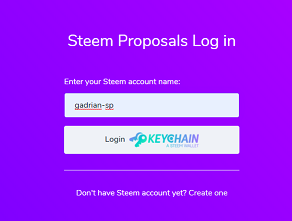
When you're not logged in, the interface will look like this:
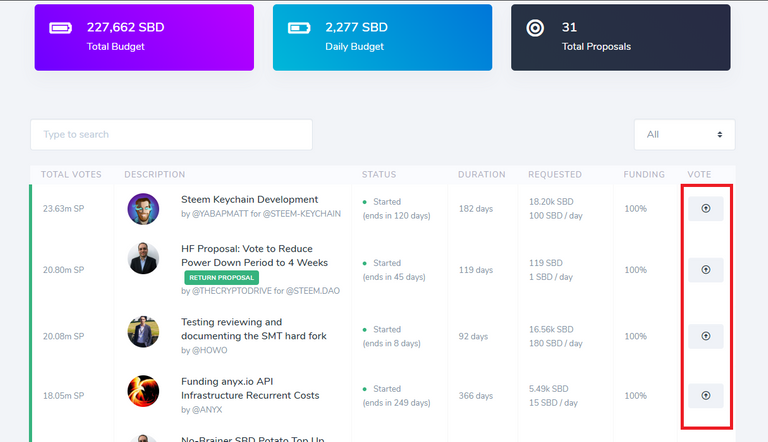
It shows you an "upvote" sign to vote for any proposal, but you don't know which are the proposals you already voted for, unless you check each one individually (you'll see later how).
If you log in, you'll know which proposals you support and which you don't:
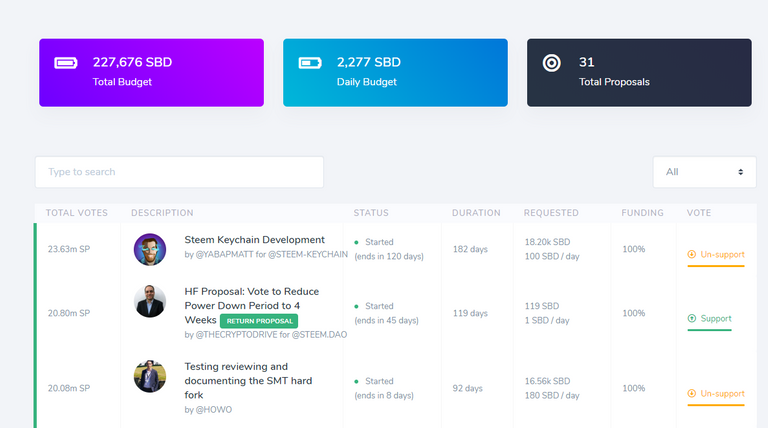
Completely off-tutorial, but maybe interesting as an exercise:
One of the alternative interfaces has an interesting feature.
Give it a try if you want with your favorite steemians, and see how they distributed votes to various proposals.
With https://joticajulian.github.io/steemexplorer/#/proposals you can easily check out the votes any account has given for the existing proposals.
Step 2 - Understanding the information presented to you
On the proposals page of the SteemProposals interface, you have two areas. One which presents information about total and daily budget in SBD and the number of total proposals (A), and the other, below, which presents the list of proposals (B). Plus filtering options between the two areas (C). See the image below.

The budget information from section A may be relevant to ponder if the amount a proposal is asking for, compared to the available funds in Steem.DAO is too much. We should keep in mind, however, that funds are paid in time to eligible proposals, and Steem.DAO budget also replenishes from inflation or donations.
The important section though is (B).
That's where information about proposals are.

Let's take them one by one and explain them, although in many cases their names are self-explanatory.
Total votes
The total amount of votes the proposal received (expressed in million SP).
Clicking on that field will open a popup window with a list with all voters and their influence in SP. If you voted for a proposal, you should be on this list when you click on the total votes. That's how you check if you voted for a proposal if you are not logged in on SteemProposals site.
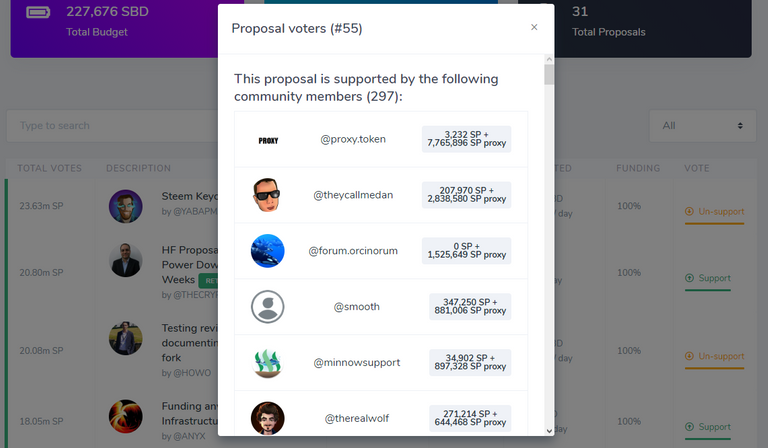
Description
Shows a brief description of the proposal, its author and the account which will receive the funds if the proposal is eligible to receive funding.
When clicked, the full text of the proposal is opened in a popup window.
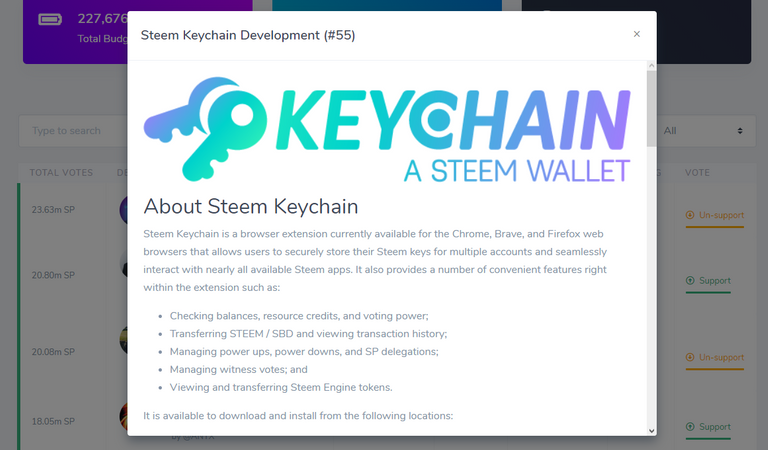
Return Proposals
You'll also notice some proposals have a "return proposal" tag.

These are normal proposals which can be voted, with the difference that all funds they receive are returned to the Steem.DAO account (by setting @steem.dao as a 100% beneficiary), thus the name - return proposal. So, practically, they keep no funding.
If you're thinking why would a proposal take funds just to give them back, because it doesn't seem to make sense, well, there are use cases for return proposals.
For example, the return proposal created by @ gtg and which I added above in the screenshot acts as a barrier. It asks for a huge amount of funding, and if the proposal is voted high enough - and it is - all the following proposals don't receive anything because the remaining funds have been allotted to this return proposal. The initial reason for its existence was to keep "bad" proposals from getting funding in case there weren't enough "good" proposals voted high.
The other use case of a return proposal has been introduced a while ago by @ thecryptodrive, it's currently standing as the second most voted proposal and in reality acts as a kind of stake-weighted poll. In that proposal, steemians are asked to vote for the proposal if they agree to reduce the power down period to 4 weeks from 13 currently (just included here so you can understand how does it work as a "poll"). Voting for the proposal would mean you agree. Not voting for it doesn't necessarily mean you disagree though. So this is not a very accurate poll, but it is an interesting way to use a proposal. And if it gathers wide and strong support, such a "poll" has its significance.
Status
The status of a proposal can be active, upcoming or ended. Only active proposals can receive funding, upcoming proposals will receive funding when they become active if they are voted above the "barrier" return proposal sets, as we talked about in the return proposals section.
Duration
When a proposal is created, one of its characteristics is the duration (time between start date and end date). How long (in days) does the proposal need funding for?
Sometimes proposers take into account the fact their proposal won't receive funding every day so they either give a longer period of time to completion, or a higher amount of funding they need, to cover the real costs.
Requested
Shows the calculated total amount of SBD needed for completing the agreed upon work or job, and the daily payments of SBD requested, if the proposal receives funding.
If you think quicker in USD than in SBD to evaluate the amounts asked by each proposal, you can easily convert between the two on https://www.coingecko.com/en/coins/steem-dollars.
Funding
A proposal can receive full, partial or no funding. This field tells you in percent how much of the requested funding the proposal currently receives. The last proposal which receives funding usually receives partial funding as you can see with the return proposal of @ gtg. Of course, this particular proposal returns the partial funding received, but regular proposals would use them and they may even say what they'll do if they receive partial funding or on and off.
Vote
This field either holds an "upvote" link from where you can support or un-support a proposal if you are not logged in, like this:
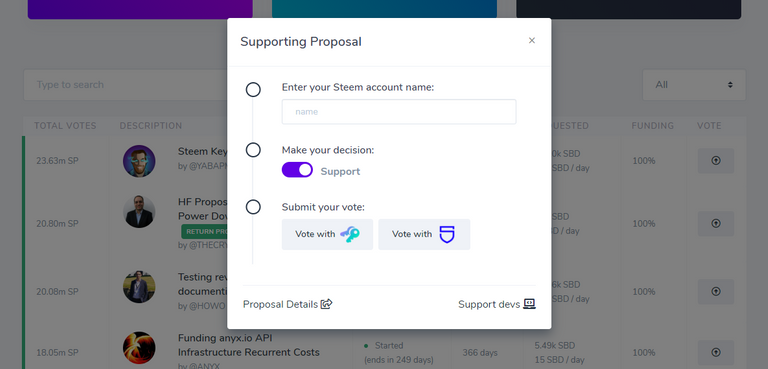
or more explicit link texts, telling you if you already supported or not a proposal, if you are logged in, and auto-selecting the opposite action on clicking, like this:
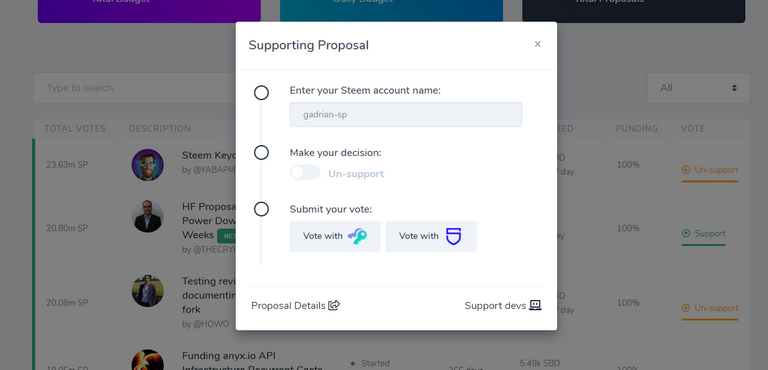
For the screenshots above, in both cases I clicked on the Steem Keychain proposal, which I already supported.
Step 3 - How do you decide who to vote for?
Here are a few key filters. You can have your own, of course.
- do you understand what the proposal is about?
- do you think funding the proposal will be beneficial to Steem?
- do you trust the proposer? does the proposal say the funds will be (partially) returned in case of non-delivery?
- would someone else be able to pick up and continue the proposed work if the original proposer goes MIA (it can be related to trust, but not necessarily - someone can get into really bad life issues)?
- does the requested funding seem excessive? are you in a position to understand that? is it explained in the text of the proposal why?
- does the duration of the proposal seem excessive? are you in a position to understand that? is it explained in the text of the proposal why?
- do other steemians you trust and with whom you share similar points of view on Steem vote for the proposal?
If you have more filters passed than not for a proposal, I believe that's a great signal to vote for it. Even if less filters are passed, if you are more inclined to put the funds to work rather than to put every roadblock possible until the perfect proposal comes in, you can vote for it.
If on the other hand you feel funds will be better used on other future proposals, then vote for gtg's return proposal. It may also keep some of the existing proposals from being funded.
One other factor that can influence your decision to vote or not a proposal is the other proposals by the same author (worker). You can see them from the "Workers" page at the top.
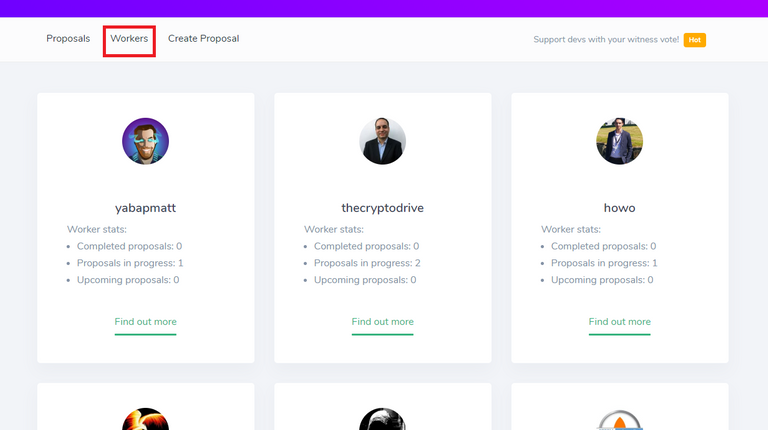
@ thecryptodrive is the only one currently with two active proposals. Let's see them closer by clicking on "Find out more".
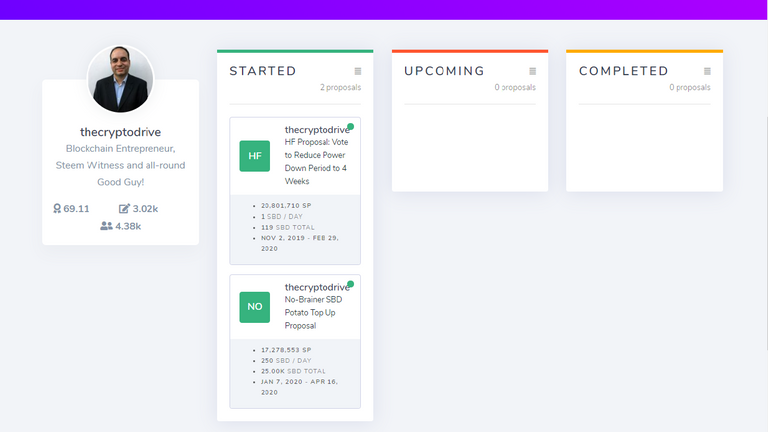
Step 4 - Cast your votes!
Ok, analysis is great, but action matters. So, after you analyze the proposals, it's time to cast your votes.
You have an unlimited number of votes. You can vote for every proposal if that's what you wish to, but that would make all your votes practically null, because you don't influence any proposal compared to others.
Step 5 - Add it to your schedule!
Make re-analyzing and updating votes a regular activity. After you've done it the first time, every other time will take less and less time. Is weekly to often for you? Then make it twice a month!
When you go though the proposals again, don't just check for new ones. Have a look at the proposals you voted for and which receive funding. Are they doing what they said they would?
If they appear to be completely off-track without reasonable explanations unvote those proposals.
Of course, in our current situation it is relatively easy to check, only a handful of proposals ever received funding so far.
Conclusion
Steem Proposals may seem inaccessible to new Steem users or if you don't have tech skills.
Granted, some projects you won't understand. But there are others that you do. Some you use every day. Others you may want to see improved or to be easier to use. Vote for them if they meet your other selection criteria!
A proposal's description at large is a blog post. It has a comments section. You like or don't like something, you want some additional details, give feedback or ask questions! The proposer can't read minds, but can definitely read comments and hopefully they do/will.
To see the blog post associated with a proposal from SteemProposals website, you scroll down to the end of the proposal's full description and click on the "Steemit" link, to see the proposal post on steemit.com. Like in the screenshot below:

Good detailed guide. Lots of great pictures too!
Thanks!
Congratulations @gadrian! You have completed the following achievement on the Steem blockchain and have been rewarded with new badge(s) :
You can view your badges on your Steem Board and compare to others on the Steem Ranking
If you no longer want to receive notifications, reply to this comment with the word
STOPTo support your work, I also upvoted your post!
Vote for @Steemitboard as a witness to get one more award and increased upvotes!
Tweeted it #posh
Congratulations! Your post has been selected as a daily Steemit truffle! It is listed on rank 12 of all contributions awarded today. You can find the TOP DAILY TRUFFLE PICKS HERE.
I upvoted your contribution because to my mind your post is at least 3 SBD worth and should receive 130 votes. It's now up to the lovely Steemit community to make this come true.
I am
TrufflePig, an Artificial Intelligence Bot that helps minnows and content curators using Machine Learning. If you are curious how I select content, you can find an explanation here!Have a nice day and sincerely yours,

TrufflePig